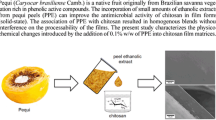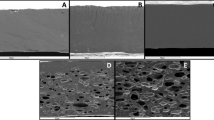Abstract
The effect of the interaction polysaccharide–polysaccharide (P–P) and polysaccharide–protein (P–Pr) blends on thermal and mechanical properties in films as biodegradable alternative of materials for food packaging was studied. Essential oils (cloves and cinnamon) emulsified were successfully incorporated into the films and evaluated as antifungal agents. Films were prepared using the film casting method. The morphological analysis showed that P–Pr films display a fractured rough surface without pores or globular formations and P–P films exhibiting continuous phases and absence of cracks. FTIR spectra evidence interactions between polysaccharides and polysaccharides-protein. Initial degradation temperature (T 5 %) decreases in two kinds of films with the addition of antifungal agents. P–Pr films showed higher maximum decomposition temperature (T max) regarding P–P films. The incorporation of carrageenan in films enhances the tensile strength and elongation at break. Higher antifungal activity against Botrytis cinerea and Rhizopus stolonifer was revealed in the films containing cinnamon oil.



Similar content being viewed by others
References
Castaño J, Bouza R, Rodríguez-Llamazares S, Carrasco C, Vinicius RVB (2012) Processing and characterization of starch-based materials from pehuen seeds (Araucaria araucana (Mol) K. Koch). Carbohydr Polym 88:299–307
Vioque J, Alaiz M, Girón-Calle J (2012) Nutritional and functional properties of Vicia faba protein isolates and related fractions. Food Chem 132:67–72
Hossain MS, Mortuza MG (2006) Chemical composition of Kalimatar, a locally grown strain of faba bean (Vicia faba L.). Pak J Biol Sci 9:1817–1822
Yusuph M, Tester RF, Ansell R, Snape CE (2003) Composition and properties of starches extracted from tubers of different potato varieties grown under the same environmental conditions. Food Chem 82:283–289
Galaska V, Dickinson E, Ledward D (2000) Influence of high pressure on interactions of 11S globulin Vicia Faba with i-carrageenan in bulk solution and at interfaces. Food Hydrocolloids 14:551–561
Castaño J, Rodríguez-Llamazares S, Contreras K, Carrasco C et al (2014) Horse chestnut (Aesculus hippocastanum L.) starch: basic physico-chemical characteristics and use as thermoplastic material. Carbohydr Polym 112:677–685
Galus S, Kadzińska J (2016) Whey protein edible films modified with almond and walnut oils. Food Hydrocolloids 52:78–86
Barceloux DG (2008) Medical toxicology of natural substances: foods, fungi, medicinal herbs, toxic plants, and venomous animals. John Wiley & Sons, Hoboken, NJ, pp 39–43
Xing F, Hua H, Nimal SJ, Zhao Y, Zhou L, Liu X, Liu Y (2014) Growth inhibition and morphological alterations of Fusarium verticillioides by cinnamon oil and cinnamaldehyde. Food Control 46:343–350
Cortés-Rojas DF, Souza CRF, Oliveira WP (2014) Encapsulation of eugenol rich clove in solid lipid carriers. J Food Eng 127:34–42
Guadarrama-Lezama AY, Dorantes-Alvarez L, Jaramillo-Flores ME, Pérez-Alonso C, Niranjan K, Gutiérrez-López GF, Alamilla-Beltrán L (2012) Preparation and characterization of non-aqueous extracts from chilli (Capsicum annuum L.) and their microencapsulates obtained by spray-drying. J Food Eng 112:29–37
Sánchez T, Aristizábal J (2007) Guía técnica para producción y análisis de almidón de yuca. Boletín de servicios agrícolas de la FAO, p 163. ISSN 1020-4334
Galliard T, Bowler P (1987) Morphological and composition of starch. In: Galliard T (ed) Starch properties and potential. John Wiley & Sons, Chichester, NJ, pp 55–78
Russ N, Zielbauer BI, Ghebremedhin M, Vilgis TA (2016) Pre-gelatinized tapioca starch and its mixtures with xanthan gum and ι-carrageenan. Food Hydrocolloids 56:180–188
Ahmad M, Hani N, Nirmal N, Fazial FF, Mohtar NF, Romli SR (2015) Optical and thermo-mechanical properties of composite films based on fish gelatin/rice flour fabricated by casting technique. Prog Org Coat 84:115–127
Liu LC, Liu K, Fishman ML, Hicks KB (2007) Composite films from pectin and fish skin gelatin or soybean flour protein. J Agric Food Chem 55:2349–2355
Huc D, Matignon A, Barey P, Desprairies M, Mauduit S, Sieffermann JM, Michon C (2014) Interactions between modified starch and carrageenan during pasting. Food Hydrocolloids 36:355–361
Zhou J, Ren L, Tong J, Xie L, Liu Z (2009) Surface esterification of corn starch films: reaction with dodecenyl succinic anhydride. Carbohydr Polym 78:888–893
Romero-Bastida C, Bello-Pérez L, García M et al (2005) Physicochemical and microstructural characterization of films prepared by thermal and cold gelatinization from non-conventional sources of starches. Carbohydr Polym 60:235–244
Sun Q, Xiong CSL (2014) Functional and pasting properties of pea starch and peanut protein isolate blends. Carbohydr Polym 101:1134–1139
Kato A (1996) Preparation and functional properties of protein–polysaccharide conjugates. Marcel Dekker Inc, New York
Moreno O, Atarés L, Chiralt A (2015) Effect of the incorporation of antimicrobial/antioxidant proteins on the properties of potato starch films. Carbohydr Polym 133:353–364
Liu X, Wang Y, Yu L, Tong Z, Chen L, Liu H, Li X (2013) Thermal degradation and stability of starch under different processing conditions. Starch-Stärke 65:48–60
Be Miller JN (2011) Pasting, paste, and gel properties of starch–hydrocolloid combinations. Carbohydr Polym 86:386–423
Matignona A, Moulina G, Bareye P, Desprairiese M, Mauduite S, Sieffermanna C, Michona JM (2014) Starch/carrageenan/milk proteins interactions studied using multiple staining and confocal laser scanning microscopy. Carbohydr Polym 99:345–355
Ibanoglu E, Erçelebi EA (2007) Thermal denaturation and functional properties of egg proteins in the presence of hydrocolloid gums. Food Chem 101:626–633
Liu HS, Xie F, Yu L, Chen L, Li L (2009) Thermal processing of starch-based polymers. Prog Polym Sci 34:1348–1368
Fitzsimons SM, Mulvihill DM, Morris ER (2008) Co-gels of whey protein isolate with crosslinked waxy maize starch: analysis of solvent partition and phase structure by polymer blending laws. Food Hydrocolloids 22:468–484
Isotton FS, Bernardo GL, Baldasso C, Rosa LM, Zeni M (2015) The plasticizer effect on preparation and properties of etherified corn starches films. Ind Crops Prod 76:717–724
Kačuráková M, Wilson RH (2001) Developments in mid-infrared FT-IR spectroscopy of selected carbohydrates. Carbohydr Polym 44:291–303
Chang-Bravo L, López-Córdoba A, Martino M (2014) Biopolymeric matrices made of carrageenan and corn starch for the antioxidant extracts delivery of Cuban red propolis and yerba mate. React Funct Polym 85:11–19
de Souza AC, Dias AM, Sousa HC, Tadini CC (2014) Impregnation of cinnamaldehyde into cassava starch biocomposite films using supercritical fluid technology for the development of food active packaging. Carbohydr Polym 102:830–837
Tian Y, Zhu Y, Bashari M, Hu X, Xu X, Jin Z (2013) Identification and releasing characteristics of high-amylose corn starch–cinnamaldehyde inclusion complex prepared using ultrasound treatment. Carbohydr Polym 91:586–589
Goñi ML, Gañán NA, Strumia MC, Martini RE (2016) Eugenol-loaded LLDPE films with antioxidant activity by supercritical carbon dioxide impregnation. J Supercrit Fluids 111:28–35
Tolstoguzov VB (1991) Functional properties of food proteins and role of protein-polysaccharide interaction. Food Hydrocolloids 4:429–468
Jackson M, Mantsch HH (1995) The use and misuse of FTIR spectroscopy in the determination of protein structure. Crit Rev Biochem Mol Biol 30:95–120
Mehyar GF, Al-Ismail K, Han JH, Chee GW (2012) Characterization of edible coatings consisting of pea starch, whey protein isolate, and carnauba wax and their effects on oil rancidity and sensory properties of walnuts and pine nuts. J Food Sci 77:52–59
Liu J, Zhan X, Wan J, Wang Y, Wang C (2015) Review for carrageenan-based pharmaceutical biomaterials: favourable physical features versus adverse biological effects. Carbohydr Polym 121:27–36
Abdou ES, Sorour MA (2014) Preparation and characterization of starch/carrageenan edible films. Int Food Res J 21(1):189–193
Sousa A, Gonçalves M (2015) Strategies to improve the mechanical strength and water resistance of agar films for food packaging applications. Carbohydr Polym 132:196–204
López C, Rodríguez F, Guarda A, Galotto M (2016) Review antioxidant films based on cross-linked methyl cellulose and native Chilean berry for food packaging applications. Carbohydr Polym 136:1052–1060
Bergo PVA, Carvalho RA, Sobral PJA, Dos Santos RMC, Da Silva FBR, Prison JM, Solorza-Feria J, Habitante AMQB (2008) Physical properties of edible films based on cassava starch as affected by the plasticizer concentration. Pack Technol Sci 21(2):85–89
Sánchez-González L, González-Martínez C, Chiralt A, Cháfer M (2010) Physical and antimicrobial properties of chitosan–tea tree essential oil composite films. J Food Eng 98(4):443–452
Bahram S, Rezaei M, Soltani M, Kamali A, Ojagh SM, Abdollahi M (2014) Whey protein concentrate edible film activated with cinnamon essential oil. J Food Process Preserv 38:1251–1258
Kechichian V, Ditchfield C, Veiga-Santos P, Tadini CC (2010) Natural antimicrobial ingredients incorporated in biodegradable films based on cassava starch. LWT Food Sci Technol 43:1088–1094
Valencia-Chamorro SA, Palou L, Del Río MA, Pérez-Gago MB (2008) Inhibition of Penicillium digitatum and Penicillium italicum by hidroxypropyl methylcellulose-lipid edible composite films containing food additives with antifungal properties. J Agric Food Chem 56:11270–11278
Singh HB, Srivastava M, Singh AB, Srivastava AK (1995) Cinnamon bark oil, a potent fungitoxicant against fungi causing respiratory tract mycoses. Allergy 50:995–999
Bassolé IHN, Juliani HR (2012) Essential oils in combination and their antimicrobial properties. Molecules 17:3989–4006
Wang R, Wang R, Yang B (2009) Extraction of essential oils from five cinnamon leaves and identification of their volatile compound compositions. Innov Food Sci Emerg Technol 10:289–292
Pinto E, Vale-Silva L, Cavaleiro C, Salgueiro L (2009) Antifungal activity of the clove essential oil from Syzygium aromaticum on Candida, Aspergillus and dermatophyte species. J Med Microbiol 58:1454–1462
Di Pasqua R, Hoskins N, Betts G, Mauriello G (2006) Changes in membrane fatty acids composition of microbial cells induced by addiction of thymol, carvacrol, limonene, cinnamaldehyde, and eugenol in the growing media. J Agric Food Chem 54:2745–2749
Manganyi MC, Regnier T, Olivier EI (2015) Antimicrobial activities of selected essential oils against Fusarium oxysporum isolates and their biofilms. S Afr J Bot 99:115–121
Kaskatepe B, Kiymaci ME, Suzuk S, Erdem SA, Cesur S, Yildiz S (2016) Antibacterial effects of cinnamon oil against carbapenem resistant nosocomial Acinetobacter baumannii and Pseudomonas aeruginosa isolates. Ind Crops Prod 81:191–194
Unlu M, Ergene E, Unlu GV, Zeytinoglu HS, Vural N (2010) Composition, antimicrobial activity and in vitro cytotoxicity of essential oil from Cinnamomum zeylanicum Blume (Lauraceae). Food Chem Toxicol 48:3274–3280
Acknowledgements
The authors thank the financial support for this work from the Program of Basal Financing Program for Scientific and Technological Centers of Excellence (PFB-27), Project Fondef IT13I20057, as well as from the Autonomous Mexico State University (UAEM-Mexico), through the Project PRODEP DSA/103.5/15/7186.
Author information
Authors and Affiliations
Corresponding authors
Electronic supplementary material
Below is the link to the electronic supplementary material.
Rights and permissions
About this article
Cite this article
Castaño, J., Guadarrama-Lezama, A.Y., Hernández, J. et al. Preparation, characterization and antifungal properties of polysaccharide–polysaccharide and polysaccharide–protein films. J Mater Sci 52, 353–366 (2017). https://doi.org/10.1007/s10853-016-0336-3
Received:
Accepted:
Published:
Issue Date:
DOI: https://doi.org/10.1007/s10853-016-0336-3




